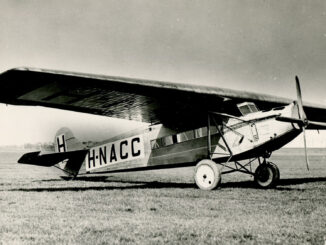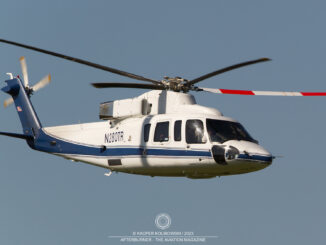
Maiden flight of PZL.44 Wicher (English: Gale), a prototype of Polish two-engine airliner.
The inter-war years were a period when aviation truly boomed all over the world. Especially in the 1930s, the popularity of air travelling was growing, along with the desire to fly faster, farther and in more comfortable conditions. Therefore, new airliners being usually low-wing aircraft of all-metal construction with retractable landing gear were introduced for use in passenger and transport aviation.
An ability to design and produce a modern aircraft was at that time a matter of prestige. Countries that aspired to play a leading role in the world, or just to be a local power, placed great importance on that ability and advertised their aircraft as a part of national pride.
Therefore, it was not surprising that also Polish authorities followed this trend and made a decision to develop a modern airliner of domestic design. In 1935, Ministerstwo Komunikacji (the Ministry of Communication) placed an order for a new passenger aeroplane intended for a national carrier, Polskie Linie Lotnicze LOT (the LOT Polish Airlines). The project was entrusted to Państwowe Zakłady Lotnicze – PZL (the State Aviation Factory), particularly to a team of engineers led by Wsiewołod Jakimiuk.
Over the years, this decision seemed to be nothing more than just a manifestation of being a European superpower, not having any economic or operational reasons. First of all, transferring the time and resources of the PZL company – in the advent of the war – from military objectives to launch a niche project of an airliner was not a reasonable decision. Especially that Jakimiuk was a recognized military aircraft engineer, involved in creation of PZL P.11 and P.24 fighters. Secondly, that even the LOT airline represented a sceptical attitude to this project – an initial forecast was that the Polish national carrier would order at least 10 new airliners, but the LOT decided to place a pre-order for just four aeroplanes.
Works on the new Polish airliner lasted two years and resulted in building just one prototype of PZL.44 Wicher. The aircraft was registered SP-BPJ and flown for the first time on 12th March 1938, piloted by then PZL test pilot Bolesław Orliński – one of the most famous and worldwide recognized Polish aviators of the time. At the end of 1938 the prototype was handed over to the LOT airline for evaluation and used operationally on domestic routes until April 1939.
The evaluation flights proved that the new Polish airliner failed to meet either the requirements stated in the above mentioned order issued by Ministerstwo Komunikacji in 1935, and the expectations of the Polish national carrier. The Wicher was slower than expected, had a long production process and, above all, was too expensive. An initial price of the PZL.44 was exceeding the price of Lockheed L-14H Super Electra more than two times.
All this time, the LOT management was openly implying that the airline was preferring the Lockheed-made aircraft and there is no need to create another airliner in Poland. In 1936, the L-10 Electra passenger aeroplane began its operational service in the LOT, that finally bought ten of them. Two years later, an order for another ten Lockheed aircraft – L-14H Super Electra – was placed, despite the fact that development of Wicher was at full swing. The L-14H airliners for the Polish national carrier arrived in April and May 1938, with the last aircraft being flown to Poland directly from Lockheed factory in Burbank, California. Parallelly with ordering the American aeroplanes, the LOT was trying to cancel the above mentioned pre-order for four PZL.44 – and finally succeeded.
As a result, the project of the most modern Polish airliner of the time was finally abandoned in the middle of 1939, due to both lack of serious interest of the LOT and without any chances to be manufactured for export. The PZL.44 Wicher remained only an unfulfilled dream of Polish aviation authorities and a symbol of wasted resources in the eve of the World War II.
With the outbreak of the war, the prototype of the PZL.44 was evacuated to Skniłów airport in Lviv, where it remained due to damage of the landing gear. It was then captured by the Soviet Army and further fate of the Polish airliner remains unknown.
An interesting fact is that there are some hypotheses concerning the planned use of Wicher aircraft for military purposes. According to them, six PZL.44 had to be ordered in a military variant, armed with three machine guns and with ability to carry bombs, and then assigned to existing bomb squadrons (one Wicher per unit). Additionally, the aircraft had to be modified for that purpose. Its range had to be extended and additional radio and photo equipment had to be installed, allowing the Wicher to perform long-range reconnaissance or bombing missions. In the light of facts that reported the Polish Air Force had problems with crews and equipment for already manufactured PZL.37 Łoś (English: Moose) bombers, such ideas seem to be totally unrealistic.
The PZL.44 Wicher was an all-metal, twin-engine and low-wing monoplane with a double empennage configuration. It also had retractable landing gear in a classic tailwheel configuration. The aircraft was equipped with modern electronic navigation devices: auto pilot, radio station, radio compass and radio equipment for landing in conditions without ground visibility.
The prototype of the Polish airliner was powered by two Wright Cyclone GR-1820 G2 radial engines of 850 hp nominal power, equipped with 3-bladed Hamilton-Standard constant-speed propellers. The PZL.44 had a crew of four – two pilots, a navigator and a flight engineer. The passenger cabin had fourteen seats in two rows. In addition, the aircraft was planned to include a buffet and a steward’s seat on board. It was also equipped with a toilet.
The aircraft had a maximum take-off weight of 9500 kg, operational altitude of 6,850 metres, top speed of approximately 370 kph and the cruising speed of 280 kph. The expected range was between 1,800 and 2,200 kilometres.
Photo: The PZL-44 ‘Wicher’ airliner standing at the airfield. Source – Narodowe Archiwum Cyfrowe (National Digital Archives), signature 3/1/0/8/1673/1, Public Domain.



